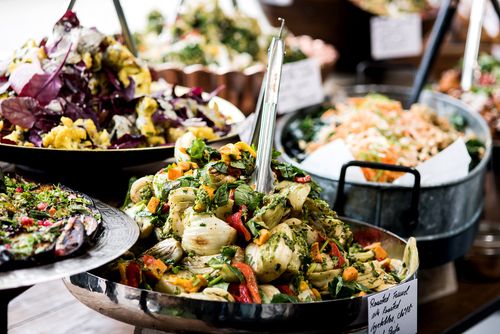 Wedding Wire’s Stephanie Weers names plant-based menus as one of 2020’s biggest wedding trends. Cuisines from all over the world offer a huge range of hearty, delicious, and healthy options. Putting together a plant-based wedding reception meal is easier than ever, and some useful tips can help you design a spread that your guests will love.
Wedding Wire’s Stephanie Weers names plant-based menus as one of 2020’s biggest wedding trends. Cuisines from all over the world offer a huge range of hearty, delicious, and healthy options. Putting together a plant-based wedding reception meal is easier than ever, and some useful tips can help you design a spread that your guests will love.
The Growing Popularity of Plant-Based Foods
Plant-based dishes offer variety, flavor, and a wealth of options to your guests. They tend to fit well in kosher and halal diets, and other religious dietary restrictions make them a logical choice. Some people with diabetes, coronary artery disease, high blood pressure, and other conditions may follow plant-based diets for health reasons. Depending on how you construct the menu, individuals with lactose intolerance or allergies to meat, fish, shellfish, and eggs can safely enjoy these meals. Others choose them for ethical reasons: reducing one’s carbon footprint, concerns about animal welfare, or objections to factory farming practices.
Regardless of the reasons, interest in meat-free and non-dairy food is growing. In another Wedding Wire piece, Whitney Teal cites survey data indicating that 22% of couples included vegan dishes in their reception meals in 2017. Some craft entirely plant-based menus, while others incorporate these foods into spreads that also have meat and dairy options.
Many Food Options With Global Cuisines
Every type of cuisine has vegetarian or vegan dishes, but some are more plant-based than others. VegNews lists eight popular vegan-friendly cuisine styles: Ethiopian, South Indian, Mediterranean, Mexican, Korean, Southern Italian, Burmese, and Chinese hot pot. You’ll notice most of this list is dominated by Asian cuisines, but Latin American, West African, and regional American cuisines also offer plenty of potential. Don’t forget that Mediterranean menus can include dishes from North Africa, Turkey, the Levant, Spain, and Southern France.
Choosing the Right Caterer Is Key
To make your reception meal vision come to life, you need the right caterer. While it’s wise to select a vendor specializing in plant-based dishes, you don’t have to limit yourself. The Knot’s Jared Misner points out that even non-veg caterers can craft a plant-based menu, but it’s vital to approach them with an open mind. Assume that the caterer knows nothing about vegetarian or vegan food, he says, and go from there.
On the other hand, Misner also warns against settling for less than what you desire from your food. If the caterer’s offerings fall short of what you want or need, don’t choose this company no matter how attractive its food or pricing is. Check out Meg Keene’s caterer hiring guide at A Practical Wedding for more tips on picking your ideal vendor.
Smart Menu Planning Tips
Weddingbee’s Laura Leavitt provides several suggestions for making your menu work. Leavitt recommends letting your guests know in advance. Besides preparing people who may expect meat on the menu, you’ll also help out people with allergies to wheat, corn, soy, and nuts. Leavitt also advises incorporating your personal favorites along with some recognizable dishes. A completely plant-based meal may elicit possible objections or concerns about protein content from guests. However, she encourages readers to be both gracious and firm in their responses. These conversations offer great opportunities to explain why you chose a plant-based menu and how it reflects your values.
Plant-based wedding reception menus can be elaborate, like the one created by American chef Matthew Kenney for a Martha Stewart Weddings piece. But you don’t have to be a master chef or even a dedicated foodie to create a phenomenal meal. You do, however, need the right caterer and a strong sense of what you want. Informing your guests, providing a variety of dishes, and tactfully handling objections are also crucial. With these good practices, you’ll pull off a delightful and unforgettable wedding-day meal.
Add Your Comment